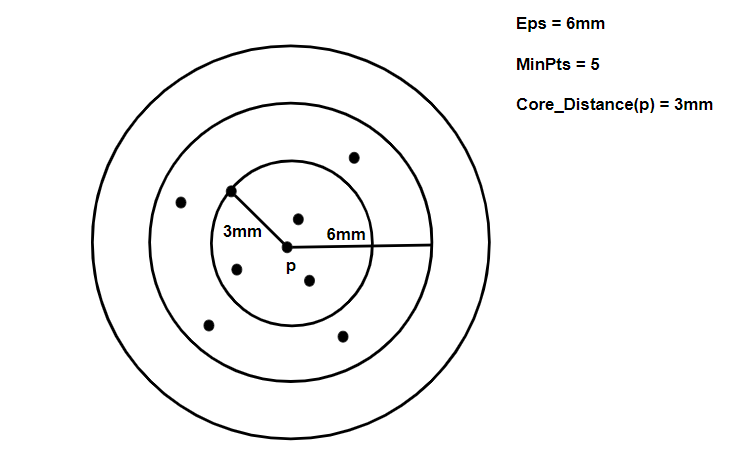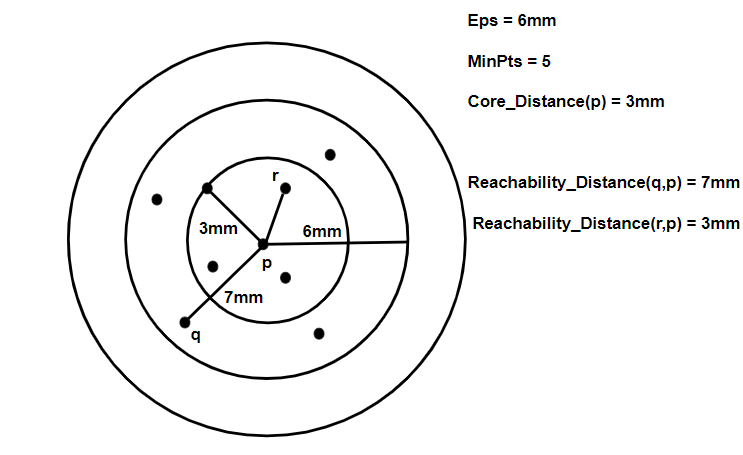先决条件: DBSCAN集群
OPTICS Clustering代表确定集群结构的订购点。它从DBSCAN聚类算法中获得启发。它为DBSCAN群集的概念增加了两个术语。他们是:-
核心距离:这是将给定点分类为核心点所需的最小半径。如果给定的点不是核心点, 则其核心距离是不确定的。

可达距离:相对于另一个数据点q(Let)定义。点p和q之间的可达距离是p的核心距离和p和q之间的欧几里德距离(或其他距离度量)中的最大值。请注意, 如果q不是核心点, 则未定义可达距离。

从某种意义上说, 该聚类技术不会将数据显式分段为聚类, 因此它与其他聚类技术不同。相反, 它会生成可到达距离的可视化, 并使用此可视化对数据进行聚类。
伪代码:
以下伪代码已从维基百科页面算法的
OPTICS(DB, eps, MinPts)
#Repeating the process for all points in the database
for each point pt of DB
#Initializing the reachability distance of the selected point
pt.reachable_dist = UNDEFINED
for each unprocessed point pt of DB
#Getting the neighbours of the selected point
#according to the definitions of epsilon and
#minPts in DBSCAN
Nbrs = getNbrs(pt, eps)
mark pt as processed
output pt to the ordered list
#Checking if the selected point is not noise
if (core_dist(pt, eps, Minpts) != UNDEFINED)
#Initializing a priority queue to get the closest data point
#in terms of Reachability distance
Seeds = empty priority queue
#Calling the update function
update(Nbrs, pt, Seeds, eps, Minpts)
#Repeating the process for the next closest point
for each next q in Seeds
Nbrs' = getNbrs(q, eps)
mark q as processed
output q to the ordered list
if (core_dist(q, eps, Minpts) != UNDEFINED)
update(Nbrs', q, Seeds, eps, Minpts)下面给出了用于更新功能的伪代码:
update(Nbrs, pt, Seeds, eps, MinPts)
#Calculating the core distance for the given point
coredist = core_dist(pt, eps, MinPts)
#Updating the Reachability distance for each neighbour of p
for each obj in Nbrs
if (obj is not processed)
new_reach_distance = max(coredist, dist(pt, obj))
#Checking if the neighbour point is in seeds
if (obj.reachable_dist == UNDEFINED)
#Updation step
obj.reachabled_dist = new_reach_distance
Seeds.insert(obj, new_reach_distance)
else
if (new_reach_distance <obj.reachable_dist)
#Updation step
o.reachable_dist = new_reach_distance
Seeds.move-up(obj, new_reach_distance)OPTICS集群与DBSCAN集群:
- 内存成本:OPTICS群集技术需要更多的内存, 因为它维护一个优先级队列(最小堆)来确定下一个数据点(就可达距离而言)与当前正在处理的点最接近。它也需要更多的计算能力, 因为最近的邻居查询比DBSCAN中的半径查询更复杂。
- 参数更少:OPTICS聚类技术不需要维护epsilon参数, 仅在上面的伪代码中给出以减少花费的时间。这导致减少了参数调整的分析过程。
-
此技术不会将给定的数据隔离到群集中。它仅产生可到达距离图, 并且在程序员的解释下相应地将点聚类。
首先, 你的面试准备可通过以下方式增强你的数据结构概念:Python DS课程。

